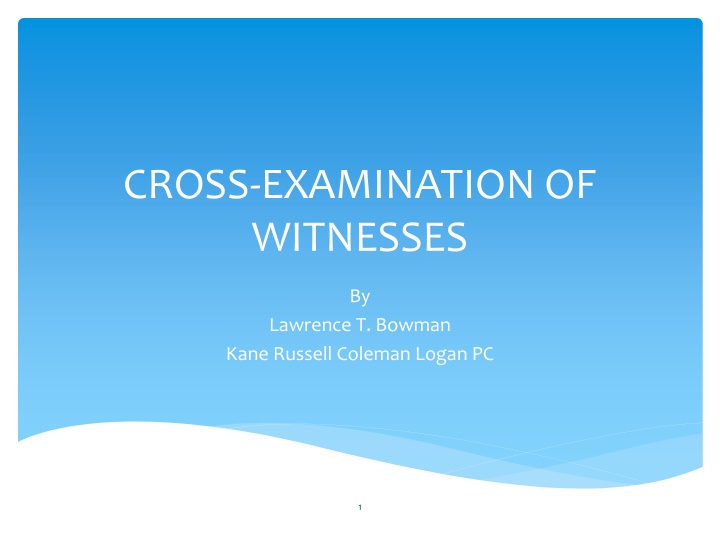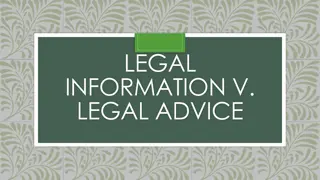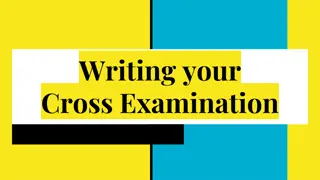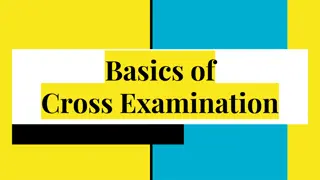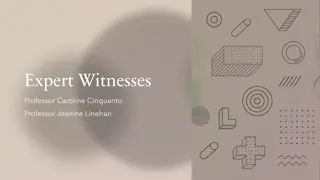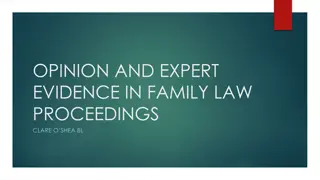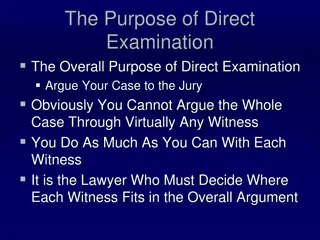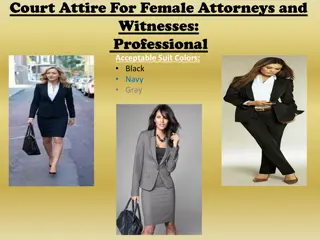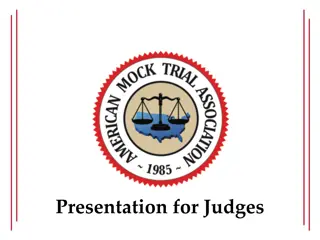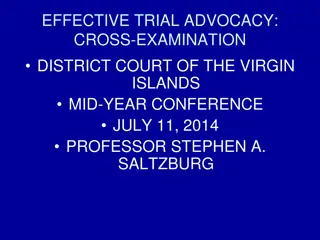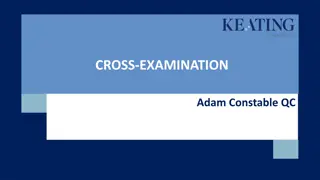Mastering Cross-Examination of Witnesses in Legal Settings
Delve into the art of cross-examination with insights from Lawrence T. Bowman and Kane Russell Coleman Logan PC. Explore the power of cross-examination in uncovering truth, the competitive nature of trials, and the distinction between discovery depositions and trial cross-examination. Learn how to effectively question witnesses and expert witnesses, using investigative, descriptive, and declarative questions to build a compelling case.
Download Presentation

Please find below an Image/Link to download the presentation.
The content on the website is provided AS IS for your information and personal use only. It may not be sold, licensed, or shared on other websites without obtaining consent from the author.If you encounter any issues during the download, it is possible that the publisher has removed the file from their server.
You are allowed to download the files provided on this website for personal or commercial use, subject to the condition that they are used lawfully. All files are the property of their respective owners.
The content on the website is provided AS IS for your information and personal use only. It may not be sold, licensed, or shared on other websites without obtaining consent from the author.
E N D
Presentation Transcript
CROSS-EXAMINATION OF WITNESSES By Lawrence T. Bowman Kane Russell Coleman Logan PC 1
GREATEST LEGAL ENGINE Cross-Examination is the greatest legal engine ever invented for the discovery of truth. You can do anything with a bayonet except sit on it. A lawyer can do anything with cross-examination if he is skillful enough not to impale his own cause upon it. John Henry Wigmore 2
CROSS-EXAMINATION Cross-examination is fun. Larry Bowman 3
CROSS-EXAMINATION IS A COMPETITION Trial is a competition between two stories. The best story always wins. Cross-Examination is a vital part of the story. 4
BIG DIFFERENCE: CROSS-EXAMINATION IN DISCOVERY DEPOSITIONS V. THE CROSS- EXAMINATION AT TRIAL Different purposes. Deposition is an examination. Fact Witnesses: Your Mission: Find out everything the witness knows. Get the witness to talk. By the mouth the fish is caught. Set clearly defined limits on the witness knowledge (closing the corral). Unpack and break down each speech. Set up witness for trial cross-examination: clear, crisp sound bites. Obtain agreement on matters not in dispute and matters which support your story. Establish a timeline sequence of events; tell the story. 5
BIG DIFFERENCE: CROSS-EXAMINATION IN DISCOVERY DEPOSITIONS V. THE CROSS- EXAMINATION AT TRIAL (cont.) Expert Witnesses The Beginning: What were you asked to do and what did you do? A clear understanding, a list, of everything the expert has done, reviewed, read, tested, etc. Find out if the expert has more work to do before trial. Avoid unpleasant surprise. Get the expert to state every opinion with its factual basis and close the corral (is that it?, have you told me everything?) Review and obtain the expert s billings. Find out if the expert has any criticism of any other expert s opinions and list the criticisms and obtain the factual basis for the criticisms. Obtain agreement on uncontested points and on points made by your experts. 6
THE WAY WE ASK QUESTIONS There are three types of questions: Investigative Descriptive Declarative 7
INVESTIGATIVE QUESTIONS I am asking this open ended question because I really don t know what you have in your head and I would like to know what you know. So please tell me. Discovery Depositions The time to ask Investigative questions: Tell me what you know. The point is to engage the witness, relax them and encourage them to spill their guts. Then get it organized. Put the witness in situ and ask them to tell you what they know, describe the scene, tell the story; what happened next. Have the imagination to set the scene; place the witness in the scene and describe the action occurring. At Trial Never ask investigative questions. They have no place in a properly constructed cross-examination at trial. If you don t know the answer at trial, don t ask the question. 8
GOOD QUESTIONS USED IN DISCOVERY DEPOSITION ON CROSS-EXAMINATION Set the scene then ask the witness: Tell us what was in your mind at that exact moment. Very hard to dissemble. Almost impossible to lie about it. What is really interesting in any story is what the story teller reveals about the content of the hearts and minds of the participants in the drama. You can paint a 2 or 3 dimensional view of a scene but the 4th dimension what was in their hearts or minds is of greater interest to the jury. The story is convincing if told with empathetic intelligence. 9
DESCRIPTIVE QUESTIONS Who, what, when, where, why and how. Drilling down after the initial description by the witness. Testing the prepared version of the testimony. Deposition Cross-Examination Ask the descriptive questions and be thorough about it after you ask the open-ended investigative questions. How do you know that you have finished with the topic? Closing the door Have you told me everything you know about this? I hate surprises at trial, so can you please think for a moment and let me know if there is anything else that you have to say about this? Then enumerate: You said 3 things and they are 1, 2, 3. Are there any more? 10
DISCOVERY DEPOSITION QUESTIONS If you are going ask a witness to explain themselves, to explain an answer; if you are going to ask them why they said something or why they think something, be prepared to get a speech. What to do if you get a speech? DON T PANIC! Just because you got the practical self-serving speech. Have the Court Reporter read it back. Take your time. Make a list and nail it down, piece by piece. Go through it, enumerate it, break it down, give it all back to the witness, ask them if you have left anything out. Descriptive questions test the speech. Does the picture make sense? This is known as closing the door or closing the corral. This is not a technique you would use at trial, only at discovery deposition in order to set the opposing witness s story in stone, and to cut off any escape routes. If accomplished effectively, this can be repeated at trial, but be very careful. If the witness gets angry or explodes on cross-examination, keep them on the stand as long as it doesn t look like you are simply keeping them on the stand. But maintain your composure. 11
TRIAL QUESTIONS: DECLARATIVE QUESTIONS These are the closed-ended questions that you use at trial to recap, summarize and emphasize the points you have extracted by using the investigative and descriptive questions in depositions before trial. Can be used at the end of a deposition as well. 12
CROSS-EXAMINATION AT TRIAL PURPOSE The destructive purpose of cross-examination is to show the lack of factual support and lack of credibility of /for your opponent s case. Another purpose of cross-examination is to show that your story is the better, more credible, and factually supported story. 13
BIG DIFFERENCE BETWEEN CROSS- EXAMINATION AT DEPOSITIONS AND AT TRIAL In Texas there is virtually no limit to the use of deposition testimony. Be aware of federal limitations and foundational requirements. Be prepared and be careful because you can really open up a can of worms. Use judgment and decide risk v. benefits of investigative and descriptive questions. In general, it is better to be prepared and better to know the good, bad and ugly about the case during discovery rather than be horrified and surprised at trial. 14
BIG DIFFERENCE BETWEEN CROSS- EXAMINATION AT DEPOSITIONS AND AT TRIAL (cont.) No Investigative or Descriptive questions at trial. Only Declarative questions at trial. 15
DISADVANTAGES OF DISCOVERY: EDUCATING THE OPPONENT The disadvantages of all this discovery, including lengthy pre-trial depositions is that your opponent and opposing witnesses are educated through participation in depositions and discovery. So, in a case where you know you have the goods on your opponent, a witness, or an expert, are you better off saving those killer points for trial? Judgment call. Present day pressures to discover and report on all factual aspects of the case. Risk averse environment. 16
STRUCTURE OF TRIAL CROSS- EXAMINATION Strong beginning Interesting middle Strongest closing 17
LIMIT AND FOCUS TRIAL CROSS- EXAMINATION In general, keep cross-examination limited to, at most, three points. It s better if it s two points. Best if it s one point. 18
PRINCIPLE OF TRIAL CROSS- EXAMINATION The artistic principle is dilution v. selection. If you make one big point, it has more impact and it is more notable and memorable than making the same point amidst a muddle of points. This is no time for Where s Waldo not the model of a well-designed cross-examination. 19
CROSS-EXAMINATION AT TRIAL Irving Younger s Ten Commandments of Cross- Examination (See Handout) 1. Be Brief We already talked abut this. Avoid a long pointless, rambling argumentative, whiney cross-examination which alienates, confuses, bores, if not angers, the jury. The point is to get to the point. Then stop. 20
CROSS-EXAMINATION AT TRIAL 2. Correct? , Agreed? , Fair? , True? . Mix it up so it doesn t sound like you are berating the witness. Correct. Correct. Correct. Use plain words. Simple sentences, end with questions like 21
CROSS-EXAMINATION AT TRIAL 3. emphasis is on the witness, his or her story, and the direct examiner who plays the role of elicitor of credible testimony to tell a persuasive story. Timeliness, graphics, photos, a few key documents and physical evidence add credibility, structure and a story line to your case. On cross-examination, the witness should be led by the nose with a series of closed-ended questions which require the answer, giving the witness little or no room for equivocation, avoidance or evasive explanation. If you let the witness tell his story and repeat it on cross-examination, it not only looks bad, but it sounds bad. Cross-examination should not be an opportunity for the opposing witness to restate his direct testimony. Use only leading questions. On direct examination, use short open-ended questions so the 22
CROSS-EXAMINATION AT TRIAL 4. you do not know the answer to on cross-examination at trial. Remember the depositions and pre-trial discovery? That was the fishing expedition. The time for investigation is over. Now is the time to get the witnesses to agree with and restate your view of the facts of the case. Be prepared Never, never, never, never, never ask a question 23
CROSS-EXAMINATION AT TRIAL 5. you a golden opportunity to drive a point home. You have to be calm, in control, and listen to each answer. If you are obsessively focused on the next question in your outline, you will miss golden opportunities to drive home big points. By the mouth the fish is caught. Take your time. Leave air space. What did the witness really say? What did they not say? Weasel words: In general, not specifically, For the most part. Pause if you get a good answer. If it is really good, ask again several times in a slightly varied way. Listen to the answer. You have your script, but every once in a while a witness gives 24
CROSS-EXAMINATION AT TRIAL 6. any. cocky or condescending. Never quarrel with the witness in cross-examination. He is a pig: He likes to roll around in wet mud. You are not a pig. Do not act like a pig. Do not wrestle with a pig. If you wrestle with the witness, you and the witness are indistinguishable. You have lost the jury. If you are quarreling with the witness, you are putting yourself on the same level as the witness and that means his credibility is equal to yours. In short, quarrel with the witness and you are losing the argument. Do Not Quarrel Cross-examination is not the time for you to show much emotion, if Better if your tone is breezy, confident (almost cheerful), but never 25
CROSS-EXAMINATION AT TRIAL 7. reason to reprise what the witness said on direct. Avoid the temptation to pick apart what the witness said on direct. Stick to your script. Exception to Rule 7 There is that rare moment when the witness steps in it on direct examination, and with the utmost care, go into that point on cross. Beware of Trojan Horses. Avoid Repetition. Avoid what the witness said on direct. There is no 26
CROSS-EXAMINATION AT TRIAL 8. examination at trial to offer an explanation. The Exception to Rule 8 If you have previously asked for an explanation in a deposition and you got back something that is useful, then you can ask the witness to repeat the explanation they gave in their deposition. Conventional wisdom never ask WHY. This can be debated, but my advice would be never ask a WHY question on cross-examination at trial unless you have asked the question previously in a deposition, received a wonderful answer, employed the techniques we are discussing to cut off any escape route and you are sure that the jury will enjoy the testimony. Disallow Witness Explanation Never, never, never, never ask a witness on cross- 27
CROSS-EXAMINATION AT TRIAL 9. The historical example involves a case where a man bit another man s nose off. After getting the witness to admit that he never saw the defendant actually bite the victim s nose off, the witnesses supposedly is asked: How can you say the defendant bit off the victim s nose if you didn t see him actually biting the victim s nose? Answer Because I saw him spit it out. Limit Questioning This is a somewhat unfair rule, but the concept makes sense. (The real mistake was asking for an explanation and asking a question when the lawyer did not know the answer beforehand.) There it is: one question too many. 28
CROSS-EXAMINATION AT TRIAL Empower the Jury 10. level. There must be the joy of discovery. There must be mystery, Romance. Human beings naturally resist having their analysis and conclusions dictated to them by some condescending lawyer. So part of the art is giving the jury some room to reach the conclusion you want them to reach independently. On cross-examination you can paint a picture, but you don t have to have the witness admit that he is wrong and you are right. He will resist, he will try to explain and you will have made a muddle of a clear and effective cross-examination. Stick with establishing facts. Save for Summation This is related to one question too many. But on a different 29
BRIAN McMONAGLE CROSS- EXAMINATION Brian McMonagle s cross-examination of the victim in the Cosby criminal case is a good example. Painted with a light brush and just added enough detail to be able to make the argument to the jury that Cosby and the victim were lovers, that this was not an aggravated sexual assault. 30
HOW TO PREPARE FOR CROSS- EXAMINATION AT TRIAL Start with the claims and defenses asserted in the pleadings. Understand the themes and the structure of the story you want to tell. View the verdict form and understand what testimony must be elicited. Write out your closing argument. Now break down the closing argument to a series of declarative statements. Decide which parts of the cross-examination should come from the mouth of individual witnesses on cross-examination. 31
HOW TO PREPARE FOR CROSS- EXAMINATION AT TRIAL (cont.) A cross-examination is nothing more than a closing argument broken down into leading questions, asking the witness to agree with the sound bites from the closing argument. 32
USE OF DOCUMENTS Less is more Avoid forcing the jury to read lengthy, complicated or convoluted paragraphs of prose. They don t like it. Use documents to punctuate testimony, to establish timeframes, sequence of events, etc. Better for the story to be told out of the mouths of witnesses. More interesting, more dramatic, simply better. The trial of a lawsuit is not a competition for who gets to send more documents to the jury. If you must delve into documents, make ample use of Trial Director, Summation, blowing up, underlining, highlighting to make the jury s job an easy one. 33
EVASIVE ANSWERS There are some gifts from God and this is one of them. An evasive answer on cross-examination in front of a jury creates an opportunity for an exception to the rule that forbids you to ask repetitive questions. To the extent the Court permits, ask the question in various different ways and from various different angles to demonstrate to the jury that the witness is evasive, is not telling the truth and cannot be trusted. An evasive answer is a gift, not a problem. Make the best of it. 34
EVASIVE ANSWERS (example) 35
PRACTICE YOUR CROSS- EXAMINATION On cross-examination, you are the focal point, not the witness. The witness is simply a foil. You should practice your timing, speed, delivery. You should attempt to make your questions simple, clear and declarative as possible. You should begin with your strong point, continue with an interesting middle point (if there is one) and end with a point that is even stronger than your first point. 36
LESS IS MORE The most devastating cross-examinations are usually the shortest ones. If you can gut the witness with one question, why ask two or three questions? What s the point? I have watched lawyers bury a few good points that could have been made on cross-examination by covering them up with a meandering muddle of unimportant points. 37
IMPEACHMENT WITH USE OF DEPOSITIONS AND PRIOR TESTIMONY You need to spend time to teach the jury the importance of prior sworn testimony. Most of the jury will have no idea what a deposition is so you have to describe it to them. Assist them with the rule that deposition testimony can be used for any purpose, which means it is of equal value to sworn testimony at trial. So, ask for permission to approach. Hand the witness a transcript with the page tagged at the location where you want to begin. Use Summation or Trial Director to show the transcript to the jury, if permitted. Begin with the caption, then go to the page where they were sworn. You took an oath to tell the truth? I advised you at the start of the depo that the testimony was just as though we were before the judge and jury in this case. You said you understood. 38
IMPEACHMENT WITH USE OF DEPOSITIONS AND PRIOR TESTIMONY (cont.) I asked you this question. You gave this answer. You can have them read their answer you can say please read your answer so the jury can hear it. Then go to the end of the deposition . At the end of the deposition I asked you if you understood my questions. Was I fair and courteous to you throughout the deposition and you said that you understood the questions and that I was fair and courteous to you? You received the transcript for your review, signed the Errata Sheet and returned it and you made no changes on the testimony that we just read to the jury. Is that fair? Some judges get impatient with this drawn out dramatization and will require you to simply repeat the question from the deposition and allow the witness to acknowledge and/or read their answer. 39
USE OF DEPOSITION AT TRIAL: THE RULE OF THREE APPLIES Avoid berating the witness with their prior testimony. Just hit the big contradictions and stop at three. Avoid nit-picking. If you waste time nit-picking the jury gets the impression you are an ann0ying pain in the ass. Instead, be happy and stick with stuff that really matters. Don t waste the jury s time establishing that you are an awful, dissatisfied person. 40
THE TONE OF CROSS-EXAMINATION Be polite, courteous, cheerful, breezy and fair. An eviscerating question is more persuasive when delivered in the same tone as dinner table conversation with friends. Control of tone is absolutely necessary in order for you to establish and maintain credibility. The minute you begin to argue or show belligerence, you have lost the argument, and perhaps worse. If you appear worried, angry, cross, the jury concludes you are a loser trying a losing case. Don t be a loser, be happy. 41
